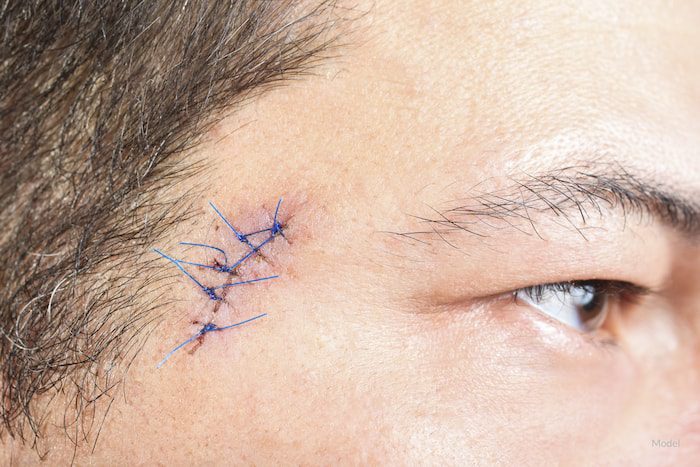Mohs Surgery | The Office of Dr. Vincent Hung
Mohs surgery treats skin cancer by carefully removing the affected area and a thin rim of tissue around it. The procedure is designed to preserve as much healthy tissue as possible.
This approach requires less reconstruction than other types of skin cancer surgery.
However, the affected skin must often be remodeled, and a scar will form.

What Is Mohs Surgery?
Mohs surgery is a complex and highly effective skin cancer treatment that includes the following steps:
Diagnosis and Evaluation
The process begins with a comprehensive examination and biopsy to identify and confirm the presence of skin cancer. The dermatologist or surgeon evaluates the type, size, and location of the cancerous lesion.
Anesthesia and Preparation
The patient is usually administered local anesthesia to numb the area where the skin cancer is located. Once the area is numb, the surgery site is prepped for the procedure.
Tissue Removal and Analysis
The surgeon removes the visible tumor and a very thin layer of surrounding tissue. The excised tissue is mapped and divided into sections, then processed and examined under a microscope in an on-site lab.
The surgeon thoroughly examines these sections to determine the pathology of the tissue. This process allows the immediate and precise evaluation of margins to detect any remaining cancer cells.
Layer-by-Layer Removal and Preservation of Healthy Tissue
If cancer cells are detected in the margins, another layer of tissue is meticulously removed. This process continues until no cancer cells are observed under the microscope.
During Mohs surgery, the surgeon preserves as much healthy tissue as possible. This technique minimizes scarring and maximizes the removal of cancerous cells, ensuring the best possible cosmetic and functional outcome.
Closure of the Surgical Site and Reconstruction
Once the cancer is completely removed, the surgeon determines the best option to close the wound, whether through direct closure, a skin graft, or allowing it to heal naturally.
Skin or cartilage grafts are used to reconstruct the areas affected by skin cancer and its removal, whether the growth was on the face, ears, arms, back, or legs.
This type of graft will depend on the area of skin cancer and how much skin needs to be removed to ensure that all of the cancer cells are eliminated.
Skin grafts are either full-thickness or split-thickness. While both techniques move the skin from a donor area (usually a place that is easy to conceal with clothing), they require a different amount of material.
- A Full-thickness graft removes a full layer of epidermis and dermis from the donor region.
- Split-thickness grafts require a complete layer of the epidermis but only a partial thickness of the dermis.
These donor samples are then processed and spread over the open wound.
Postoperative Care
Following the surgery, the patient is advised on wound care and provided with instructions for postoperative care. Proper care is essential for optimal healing and to reduce the risk of infection or complications.
What Kinds of Scars Develop?
Your Mohs surgery scar will depend on the size, location, and shape of the tumor, as well as the types of reconstruction techniques required.
In certain situations, when the cancer is small, the skin can be pulled together and sutured closed. This technique usually results in a minimal, linear scar that tends to fade nicely on its own but can still benefit from scar reduction techniques.
In other situations, when a skin or cartilage graft is required, the resulting scar may be round or rectangular and more visibly pronounced.

How Can You Reduce the Appearance of Mohs Scars?
While scars are a natural part of the body’s healing process, these seven tips can help reduce their appearance and promote a smoother, more aesthetically pleasing outcome.
1. Follow All Postoperative Instructions
It’s essential to follow your surgeon’s post-surgical instructions carefully. Keep the surgical site clean and protected according to their directions and follow the recommended wound care routine to aid in proper healing.
2. Stay Out of the Sun
Skin grafts are more susceptible to sun damage than the surrounding skin and burn easily. This exposure also causes scars to take on a dark brown color.
To prevent your scar from darkening, protect the healing incision or graft by keeping it covered and out of the sun and using a high-SPF sunscreen when your doctor clears you to do so.
3. Use Moisturizers to Massage the Scar(s)
Post-surgical massages are performed to promote wound healing and reduce the appearance of scars. Massaging these scars breaks up scar tissue and can reduce the size and profile of the wound. By adding moisturizing lotions or oils, you can soften the scar tissue further and improve the appearance of healing skin, but be sure to consult your doctor before massaging the area and about the moisturizer you want to use.
When massaging, gently rub the scar and adjacent areas to soften the scar tissue, stimulate collagen production, and promote skin remodeling. Scar massage should be performed two or three times a day for five to ten minutes at a time,
4. Use Scar-Reducing Creams or Gels Containing Silicone
Dermatologists and plastic surgeons often recommend silicone-based gels, creams, or strips to minimize scarring.
- Silicone strips are reusable bandages that should be worn 12 hours daily for at least three months.
- Silicone creams and gels are applied directly to the scar to reduce the pigment.
These products should be applied to the healing wound according to the provider’s instructions and typically can be used once the incisions have completely healed.
5. Consider Laser Treatments
Some individuals opt for laser therapy or other non-invasive procedures to minimize the appearance of scars. These treatments can help flatten and fade scars to improve skin texture.
6. Maintain a Healthy Diet and Hydration
Eating a balanced diet rich in nutrients and staying hydrated can support the body’s natural healing process. Vitamins, minerals, and proper hydration are a vital part of optimal wound healing.
7. Consult a Dermatologist or Plastic Surgeon
If concerned about scarring, consult a dermatologist or plastic surgeon who specializes in scar revision. They can recommend additional treatments or techniques tailored to your individual needs.
Minimizing Mohs surgery scars involves a combination of proper wound care, protection from the sun, and, at times, additional treatments to maximize the skin’s ability to heal.
Give Your Scars Time to Fade
Scar healing is a gradual process. After doing all you can to minimize your scarring, be patient and allow sufficient time for the scar to mature. Initially, scars may appear red or raised but tend to improve and fade over time.
Find Out More About Mohs Scar Reduction in Pasadena, CA
To learn more about how to reduce scars or to find a surgeon who performs Mohs surgery near Pasadena or Los Angeles, California, call Dr. Vincent Hung at (626) 432-5032 or fill out our online contact form.
